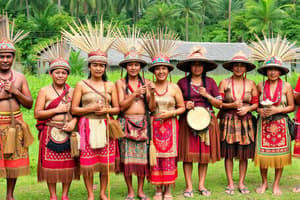Podcast
Questions and Answers
What was the status of the teaching and learning of specialties during the precolonial period in the Philippines?
What was the status of the teaching and learning of specialties during the precolonial period in the Philippines?
- Scattered and casual (correct)
- Non-existent
- Hierarchical and strict
- Formal and structured
Which colonial period in the Philippines transformed communities into schools and workshops?
Which colonial period in the Philippines transformed communities into schools and workshops?
- Japanese colonial period
- American colonial period
- Spanish colonial period (correct)
- British colonial period
When did the Academia de las Bellas Artes, an important institution for arts, emerge in the Philippines?
When did the Academia de las Bellas Artes, an important institution for arts, emerge in the Philippines?
- Spanish colonial period (correct)
- Modern period
- Precolonial period
- American colonial period
What characterized the historical backdrop of specialties training in the Philippines during the pre-Hispanic period?
What characterized the historical backdrop of specialties training in the Philippines during the pre-Hispanic period?
In what way did the historical backdrop of specialties training in the Philippines change from the pre-Hispanic to the modern period?
In what way did the historical backdrop of specialties training in the Philippines change from the pre-Hispanic to the modern period?
Which period marked a significant shift in the teaching and learning process of crafts in the Philippines?
Which period marked a significant shift in the teaching and learning process of crafts in the Philippines?
What was the traditional entrance method to castles mentioned in the text?
What was the traditional entrance method to castles mentioned in the text?
What does 'balangay' mean in the Austronesian language?
What does 'balangay' mean in the Austronesian language?
When was the oldest known balangay carbon-dated to?
When was the oldest known balangay carbon-dated to?
Which traditional art form symbolizes Ifugao ancestors who have attained demigod status?
Which traditional art form symbolizes Ifugao ancestors who have attained demigod status?
What is significant about the Tinaggu in Ifugao culture?
What is significant about the Tinaggu in Ifugao culture?
What does the balangay represent in terms of Filipino craftsmanship?
What does the balangay represent in terms of Filipino craftsmanship?
What type of subjects were taught in the Spanish pilgrim Philippines communities?
What type of subjects were taught in the Spanish pilgrim Philippines communities?
When did Crafts instruction in the Philippines achieve its peak?
When did Crafts instruction in the Philippines achieve its peak?
Which institution brought an end to the schools in Spanish pilgrim Philippines communities?
Which institution brought an end to the schools in Spanish pilgrim Philippines communities?
Which subjects came to be valued for their purely intellectual worth during the American time period?
Which subjects came to be valued for their purely intellectual worth during the American time period?
Which crafts subjects were retained in the public grade educational system after offerings under the American state-funded educational system were discarded?
Which crafts subjects were retained in the public grade educational system after offerings under the American state-funded educational system were discarded?
What replaced crafts as subjects in the educational system during the American time period?
What replaced crafts as subjects in the educational system during the American time period?
Flashcards are hidden until you start studying
Study Notes
Filipino Creative Crafts
- The Philippines is a melting pot of cultures, each with their own unique art forms passed down through generations.
- These art forms range from intricate weavings to pottery, tattoos, and bamboo crafts, to music, dance, textile art, and wood carving.
History of Indigenous Crafts in the Philippines
- Precolonial period: scattered and casual instructing and learning of specialties.
- Spanish colonial period: communities were transformed into schools and workshops of carpentry, iron works, drawing, and painting.
- Modern period: Academia de las Bellas Artes (1785) and modern work and specialties were introduced.
Traditional Arts
- Weaving: basket weaving, backstrap loom weaving, headgear weaving, fishnet weaving, and other forms.
- Balangay: an Austronesian word for "sailboat", first mentioned in the 16th Century in the Chronicles of Pigafetta, and is known as the oldest watercraft found in the Philippines.
- Balangay is evidence of early Filipino craftsmanship and seamanship skills during precolonial times.
Carving
- The Tinaggu: a human-like pattern that symbolizes Ifugao ancestors who have attained the status of demigods in the afterlife.
American Colonial Period
- Crafts instruction in the Philippines reached its peak during the American period when the educational system was modified and extended to include modern work and specialties.
- Crafts subjects offered under the American system included painting, mold, engineering, photography, printmaking, move, theater, and silver screen.
Present Day
- Today, woodwork and mud demonstrating are still part of the present educational curriculum of the public grade educational system.
- Artworks have been replaced by painting, mold, engineering, photography, printmaking, move, theater, and silver screen.
Studying That Suits You
Use AI to generate personalized quizzes and flashcards to suit your learning preferences.




